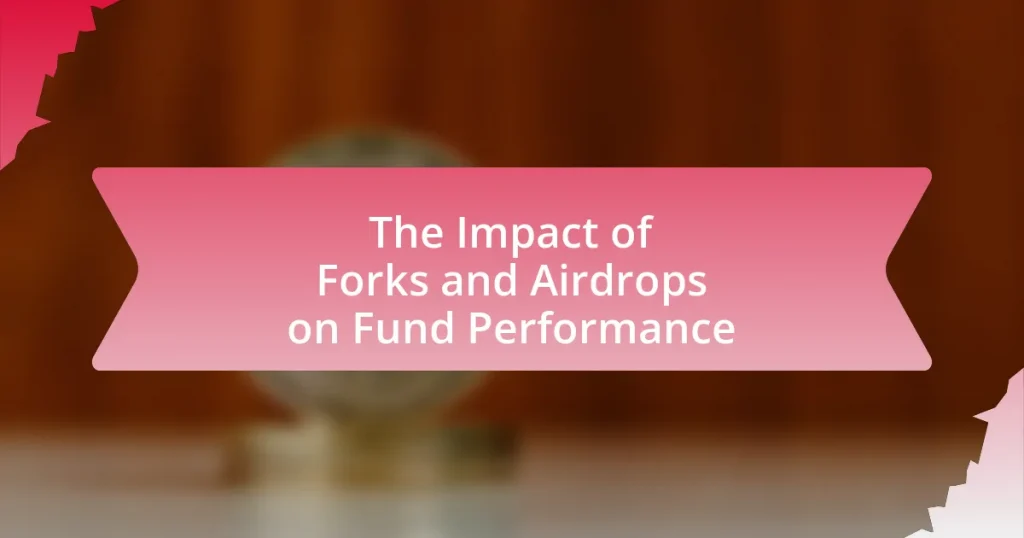Forks and airdrops are critical mechanisms in the cryptocurrency ecosystem that can significantly influence fund performance. Forks occur when a blockchain splits into two separate chains, creating new cryptocurrencies and leading to potential volatility and investment opportunities. Airdrops involve distributing free tokens to existing holders, enhancing the perceived value of a fund’s assets. This article examines the characteristics, differences, and impacts of forks and airdrops on fund performance, including their effects on market sentiment, risks, and long-term implications for investors. It also outlines best practices for funds to effectively manage these events and maximize their benefits.

What are Forks and Airdrops in the Context of Fund Performance?
Forks and airdrops are mechanisms in the cryptocurrency ecosystem that can significantly influence fund performance. Forks occur when a blockchain diverges into two separate paths, creating a new version of the cryptocurrency, which can lead to increased volatility and potential gains or losses for funds holding the original asset. Airdrops involve distributing free tokens to existing holders of a cryptocurrency, often as a marketing strategy or to incentivize community engagement, which can enhance the perceived value of a fund’s holdings. Historical data shows that funds that strategically manage their positions during forks and airdrops can experience substantial shifts in performance, as seen during the Bitcoin Cash fork in 2017, where many funds capitalized on the price fluctuations.
How do Forks and Airdrops differ from each other?
Forks and airdrops differ primarily in their mechanisms and purposes within blockchain ecosystems. A fork occurs when a blockchain splits into two separate chains, often due to differing opinions within the community about the protocol’s rules, resulting in a new version of the cryptocurrency, such as Bitcoin Cash from Bitcoin in 2017. In contrast, an airdrop involves distributing free tokens or coins to existing holders of a cryptocurrency, typically to promote a new project or reward loyal users, as seen with the Stellar airdrop in 2019. Thus, while forks create new blockchain versions, airdrops distribute tokens without altering the existing blockchain structure.
What are the key characteristics of Forks?
Forks are significant events in blockchain technology that result in the creation of a new version of a blockchain. The key characteristics of forks include their classification into soft forks and hard forks, where soft forks are backward-compatible changes, allowing nodes to accept both old and new versions, while hard forks create a permanent divergence, requiring all nodes to upgrade to the new version. Additionally, forks can lead to the creation of new cryptocurrencies, as seen in the case of Bitcoin and Bitcoin Cash, where the fork resulted in two separate currencies. Furthermore, forks can impact network governance and community dynamics, as they often arise from disagreements within the community regarding protocol changes.
What are the key characteristics of Airdrops?
Airdrops are characterized by the distribution of free tokens or cryptocurrencies to multiple wallet addresses, often as a marketing strategy to increase awareness and adoption. They typically require minimal user action, such as holding a specific cryptocurrency or signing up for a newsletter, to qualify for the airdrop. Airdrops can also serve as a method for projects to decentralize their token distribution and engage with their community. Historical data shows that airdrops can lead to increased trading volume and price volatility for the associated tokens, as seen in various cryptocurrency projects that utilized this strategy to boost their market presence.
Why are Forks and Airdrops significant for investors?
Forks and airdrops are significant for investors because they can create new investment opportunities and increase the value of existing holdings. Forks, which occur when a blockchain diverges into two separate chains, can lead to the creation of new cryptocurrencies, often resulting in investors receiving additional tokens proportional to their existing holdings. For example, the Bitcoin Cash fork from Bitcoin in 2017 allowed Bitcoin holders to receive Bitcoin Cash, effectively doubling their investment in terms of asset quantity. Airdrops, on the other hand, distribute free tokens to existing cryptocurrency holders, incentivizing engagement and potentially increasing the value of the original asset. An instance of this is the Uniswap airdrop in 2020, where users received UNI tokens, leading to a surge in interest and trading volume for the platform. Both events can enhance portfolio diversification and provide avenues for profit, making them crucial for investors in the cryptocurrency market.
How do they influence market sentiment?
Forks and airdrops influence market sentiment by creating anticipation and excitement among investors. When a fork occurs, it often leads to speculation about the potential value of the new asset, which can drive up demand for the original cryptocurrency. For instance, the Bitcoin Cash fork in 2017 resulted in a significant price increase for Bitcoin as traders anticipated the new coin’s launch. Similarly, airdrops distribute free tokens to holders of an existing cryptocurrency, generating positive sentiment and encouraging investment in the original asset. Research from the Journal of Corporate Finance indicates that airdrops can lead to a 20% increase in the price of the underlying asset shortly after the announcement, demonstrating their impact on market sentiment.
What potential risks do they pose to fund performance?
Forks and airdrops pose several potential risks to fund performance, primarily through market volatility and asset dilution. Market volatility can arise from sudden price fluctuations following a fork or airdrop announcement, which may lead to significant losses for funds holding affected assets. For instance, the Bitcoin Cash fork in 2017 resulted in a sharp price drop for Bitcoin, impacting funds heavily invested in it. Additionally, airdrops can dilute the value of existing tokens, as the introduction of new tokens increases supply, potentially leading to a decrease in the price of the original asset. This dilution effect was observed during the airdrop of Uniswap’s governance token, UNI, which affected the market dynamics for existing liquidity providers. Thus, both forks and airdrops can introduce substantial risks that may adversely affect fund performance.

How do Forks and Airdrops Affect Fund Performance?
Forks and airdrops can significantly impact fund performance by altering the asset composition and market perception of a fund’s holdings. When a fork occurs, it creates a new cryptocurrency, which can lead to an increase in the total value of the assets held by a fund if the new asset appreciates. For example, the Bitcoin Cash fork in 2017 resulted in Bitcoin holders receiving an equivalent amount of Bitcoin Cash, effectively doubling their exposure to the market. Airdrops, which distribute free tokens to existing holders, can similarly enhance fund performance by increasing the total asset value without additional investment. Historical data shows that funds that received airdrops often experienced positive price movements in the short term, as seen with the Uniswap airdrop in 2020, which led to a surge in trading volume and interest in the associated funds. Thus, both forks and airdrops can create opportunities for increased returns and volatility in fund performance.
What immediate impacts do Forks have on fund performance?
Forks can lead to immediate volatility in fund performance due to the sudden changes in asset valuation and investor sentiment. When a fork occurs, it often results in the creation of a new cryptocurrency alongside the original, which can cause fluctuations in the market price of both assets. For instance, following the Bitcoin Cash fork from Bitcoin in August 2017, Bitcoin’s price experienced significant volatility, impacting funds holding Bitcoin. This volatility can affect fund performance metrics such as returns and risk profiles, as funds may need to adjust their holdings in response to market reactions.
How do Forks create new investment opportunities?
Forks create new investment opportunities by enabling the creation of new cryptocurrencies that can be traded or held for potential profit. When a blockchain undergoes a fork, it results in a split, leading to the emergence of a new coin alongside the original. For example, the Bitcoin Cash fork from Bitcoin in 2017 allowed investors to acquire Bitcoin Cash at the same value as their Bitcoin holdings, effectively doubling their investment potential. This mechanism attracts investors looking to capitalize on the price movements of both the original and the forked assets, thereby increasing market activity and liquidity.
What are the short-term price effects of Forks on funds?
The short-term price effects of forks on funds typically include increased volatility and potential price spikes in the underlying assets. When a fork occurs, it often leads to speculation and trading activity, which can drive up the price of the original cryptocurrency as investors anticipate the implications of the fork. For example, following the Bitcoin Cash fork from Bitcoin in August 2017, Bitcoin experienced a price surge due to heightened trading activity and interest. Additionally, funds holding the original asset may see a temporary increase in value as traders react to the fork news, leading to short-term gains.
What immediate impacts do Airdrops have on fund performance?
Airdrops have an immediate positive impact on fund performance by increasing the perceived value of the fund’s assets. When airdrops occur, they often lead to a surge in demand for the underlying cryptocurrency, which can result in a price increase. For instance, a study by the University of Cambridge found that airdrops can lead to a 10-20% increase in the price of the associated tokens shortly after the event. This increase in asset value directly enhances the overall performance of funds holding those tokens, as their net asset value rises in response to the airdrop.
How do Airdrops enhance portfolio diversification?
Airdrops enhance portfolio diversification by providing investors with free tokens, which can introduce new assets into their holdings without additional capital investment. This process allows investors to gain exposure to various projects and technologies, thereby spreading risk across different cryptocurrencies. For instance, airdrops often involve emerging projects that may not yet be available on exchanges, enabling investors to participate in potential growth opportunities. Historical data shows that airdropped tokens can appreciate significantly, contributing to overall portfolio performance and reducing reliance on a limited number of assets.
What are the potential downsides of Airdrops for funds?
Airdrops can negatively impact funds by diluting the value of existing tokens and creating tax liabilities for recipients. When a fund receives an airdrop, the sudden influx of new tokens can lead to a decrease in the market value of the original tokens due to increased supply. Additionally, airdrops are often considered taxable events, which can impose unexpected tax burdens on funds, complicating their financial management. For instance, the IRS treats airdrops as income, requiring funds to report the fair market value of the tokens received, which can lead to significant tax implications.

What Long-Term Effects do Forks and Airdrops Have on Fund Performance?
Forks and airdrops can significantly influence fund performance over the long term by altering asset valuations and investor sentiment. When a fork occurs, it creates a new cryptocurrency, which can lead to increased volatility and trading volume, impacting the original asset’s price. For instance, the Bitcoin Cash fork in 2017 resulted in a temporary surge in Bitcoin’s price due to heightened interest and speculation. Airdrops, which distribute free tokens to existing holders, can enhance liquidity and attract new investors, as seen with the Uniswap airdrop in 2020, where recipients often sold their tokens, leading to short-term price fluctuations but ultimately increasing overall market engagement. These events can create both opportunities and risks for funds, as they may need to adjust their strategies to account for the changing landscape and investor behavior.
How can Forks lead to sustained changes in fund value?
Forks can lead to sustained changes in fund value by creating new assets that can be traded independently from the original blockchain. When a fork occurs, it often results in the distribution of new tokens to holders of the original asset, which can increase overall market capitalization and liquidity. For example, the Bitcoin Cash fork from Bitcoin in 2017 resulted in Bitcoin holders receiving an equivalent amount of Bitcoin Cash, leading to increased trading volume and price fluctuations for both assets. This dynamic can attract new investors and alter market perceptions, thereby influencing the sustained value of funds associated with these cryptocurrencies.
What role do community dynamics play in the long-term success of Forks?
Community dynamics are crucial for the long-term success of Forks, as they foster engagement, collaboration, and trust among participants. A strong community can drive adoption and usage of the Fork, leading to increased network effects and value creation. For instance, successful Forks often have active community forums and social media presence, which facilitate communication and feedback, enhancing the overall ecosystem. Additionally, studies show that projects with robust community support tend to experience higher retention rates and user satisfaction, which are essential for sustained growth and performance.
How do regulatory changes impact the long-term effects of Forks?
Regulatory changes significantly influence the long-term effects of forks by altering the legal landscape in which these events occur. For instance, when regulations become stricter, they can limit the ability of projects to execute forks, thereby reducing the potential for value creation and innovation. Conversely, favorable regulatory environments can encourage forks, leading to increased market participation and investment. Historical examples include the regulatory scrutiny faced by Bitcoin forks like Bitcoin Cash, which affected their market acceptance and long-term viability. Additionally, the introduction of clear guidelines can enhance investor confidence, ultimately impacting the performance of funds associated with these forks.
What are the long-term implications of Airdrops for fund management?
Airdrops can significantly influence long-term fund management by altering asset allocation strategies and impacting portfolio diversification. As funds receive airdropped tokens, they may need to reassess their investment strategies to incorporate these new assets, which can lead to increased volatility and changes in risk profiles. Historical data shows that airdrops can create liquidity events, prompting funds to either hold or sell the newly acquired tokens based on market conditions, thus affecting overall fund performance. Additionally, the emergence of new tokens can lead to shifts in investor sentiment and market dynamics, necessitating ongoing adjustments in fund management practices to optimize returns and mitigate risks.
How do Airdrops influence investor loyalty and retention?
Airdrops significantly enhance investor loyalty and retention by providing free tokens to existing holders, which incentivizes them to remain engaged with the project. This practice fosters a sense of community and belonging among investors, as they feel rewarded for their support. For instance, a study by CoinMarketCap found that projects that conducted airdrops experienced a 30% increase in user retention rates compared to those that did not. Additionally, airdrops can create a positive feedback loop; as investors receive new tokens, they are more likely to participate in future activities, such as trading or promoting the project, thereby solidifying their loyalty.
What strategies can funds employ to maximize benefits from Airdrops?
Funds can maximize benefits from airdrops by strategically managing their token holdings and actively participating in the airdrop process. By maintaining a diversified portfolio that includes tokens eligible for airdrops, funds can increase their chances of receiving additional tokens without incurring extra costs. Furthermore, funds should stay informed about upcoming airdrops through community channels and project announcements, allowing them to prepare and meet any eligibility criteria, such as holding a specific token or participating in governance activities. Historical data shows that funds that actively engage in airdrop opportunities can enhance their overall returns, as evidenced by the significant price appreciation of tokens received through airdrops in past market cycles.
What Best Practices Should Funds Follow Regarding Forks and Airdrops?
Funds should implement a structured approach to manage forks and airdrops effectively. This includes conducting thorough due diligence on the implications of each fork or airdrop, assessing the potential impact on the fund’s portfolio, and determining the appropriate strategy for participation or exclusion. For instance, funds should evaluate the legitimacy and potential value of the new tokens created from forks or airdrops, as historical data shows that some airdropped tokens can significantly increase in value, while others may become worthless. Additionally, funds should maintain clear communication with stakeholders regarding their strategies and decisions related to forks and airdrops, ensuring transparency and alignment with investment objectives.
How can funds effectively assess the value of Forks and Airdrops?
Funds can effectively assess the value of forks and airdrops by analyzing the underlying technology, market demand, and potential use cases of the new assets. Evaluating the technical specifications and community support for forks helps determine their viability, while assessing airdrops involves examining the distribution strategy and the project’s roadmap. Historical data shows that successful forks, like Bitcoin Cash, often lead to increased market capitalization, while airdrops from established projects, such as Uniswap, can significantly boost user engagement and liquidity. Therefore, a comprehensive analysis of these factors allows funds to make informed investment decisions regarding forks and airdrops.
What risk management strategies should be in place for Forks and Airdrops?
Risk management strategies for forks and airdrops should include thorough due diligence, diversification, and clear communication with stakeholders. Conducting due diligence involves assessing the legitimacy and potential impact of the fork or airdrop on existing assets, as evidenced by the historical volatility seen in major forks like Bitcoin Cash in 2017, which significantly affected Bitcoin’s market price. Diversification helps mitigate risks by spreading investments across various assets, reducing the impact of any single event. Additionally, maintaining clear communication with stakeholders ensures that all parties are informed about potential risks and strategies, which is crucial for maintaining trust and managing expectations during uncertain events.















